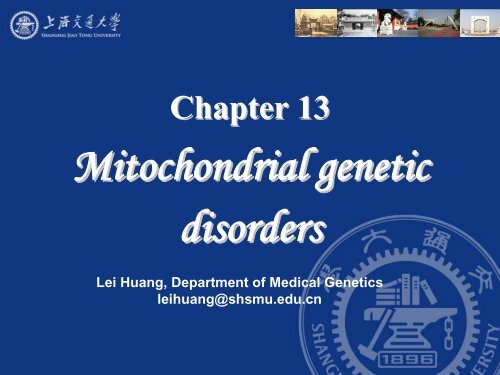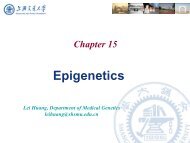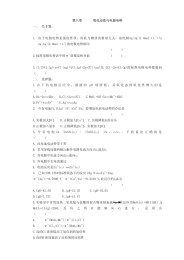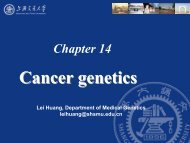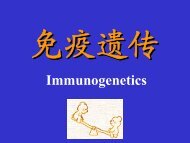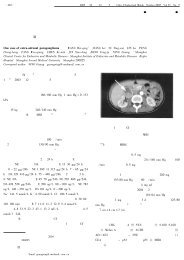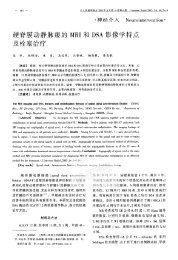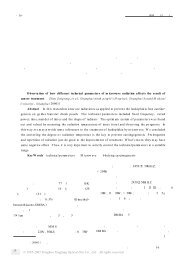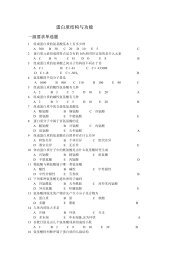线粒体基因病
线粒体基因病
线粒体基因病
Create successful ePaper yourself
Turn your PDF publications into a flip-book with our unique Google optimized e-Paper software.
Chapter 13<br />
Mitochondrial genetic<br />
disorders<br />
Lei Huang, Department of Medical Genetics<br />
leihuang@shsmu.edu.cn
Outline<br />
Structure of human mitochondrial<br />
DNA (mtDNA)<br />
Characteristics of Mitochondrial<br />
Inheritance<br />
Mutations in mtDNA and Disease
Mitochondrial<br />
1894, discover Mit<br />
1963, mtDNA<br />
1987, mtDNA & Leber
Structure of human mitochondrial DNA (mtDNA)<br />
‣No.25 chromosome<br />
or M chromosome<br />
‣Double strand (closed ring)<br />
Heavy strand ; Light strand<br />
‣ 16 569 bp 37 genes<br />
• 13 genes enconding proteins<br />
involved respiratory chain<br />
• 22 genes enconding tRNA<br />
• 2 genes enconding rRNA
Characteristics of Mitochondrial Inheritance<br />
Replication: 半 自 主 性 复 制<br />
Special Codon:UGA(Trp)<br />
Maternal inheritance( 母 系 遗 传 )<br />
Replicative segregation( 复 制 分 离 ): mtDNA<br />
distributed randomly between the two daughter cells<br />
Quantitative threshold ( 阈 值 效 应 ):<br />
Homoplasmy and heteroplasmy<br />
High mutation frequency: 20 times higher
•The maternal inheritance : reflects the fact that sperm<br />
mitochondria are generally eliminated from the embryo, so<br />
that mtDNA is almost always inherited entirely from the<br />
mother.
Mitochondrial genetic bottleneck ( 遗 传 瓶 颈 )<br />
Oocyte Mature oocyte Early development<br />
100000 mt 10~ 100 mt 100000 mt<br />
Within the maturity of the oocyte, the amount<br />
of mitochondria decreased rapidly, from<br />
100,000 to less than 100, this is “genetic<br />
bottleneck”.<br />
It can decrease the probability of diseasecarrying<br />
mother to transmit the mutant gene<br />
to their offspring.
Homoplasmy ( 纯 质 ) : 指 一 种 组 织 或 细 胞 中 的 线<br />
粒 体 的 基 因 完 全 相 同 , 即 全 为 突 变 基 因 或 全 为 野<br />
生 型 的 细 胞 或 组 织 。<br />
Heteroplasmy ( 杂 质 ) : 指 一 种 组 织 或 细 胞 中 的<br />
线 粒 体 的 基 因 一 部 分 为 突 变 型 , 一 部 分 为 野 生<br />
型 。
Quantitative threshold ( 阈 值 效 应 )<br />
The mutant mtDNA in heteroplasmy will only<br />
lead to onset of the disease when it significantly<br />
with a quantitative threshold .<br />
突 变 的 mtDNA 的 数 量 超 过 一 定 限 度 时 , 会 出 现 临 床 症 状 。<br />
( 阈 值 )<br />
The severity of the disease associated with a<br />
mtDNA mutation will depend on the relative<br />
proportion of normal and mutant mtDNA in the<br />
cells of a particular tissue<br />
突 变 mtDNA 所 占 比 例 与 临 床 症 状 的 表 现 程 度 相 关 。
Compare with nuclear DNA (nDNA)<br />
nDNA mt DNA<br />
Location nucleus cytoplasm<br />
Structure double double strand(closed<br />
strand(linear) ring)<br />
Number of bp 3.1 x 10 9 16 569<br />
Number of genes 30,000-35,000 37<br />
Copy of genes single multiple<br />
Intervening yes<br />
no<br />
sequence<br />
Frequency of low<br />
high<br />
mutation
ATP 的 生 成 和 利 用<br />
CO 2<br />
代 谢 物<br />
分<br />
解<br />
氧<br />
化<br />
能<br />
H 2 O<br />
热 能 ( 散 发 )<br />
化 学 能<br />
( 储 能 )<br />
ATP<br />
C<br />
C~P<br />
ADP<br />
+<br />
能<br />
机 械 能 ( 肌 肉 收 缩 )<br />
化 学 能 ( 合 成 代 谢 )<br />
渗 透 能 ( 吸 收 分 泌 )<br />
电 能 ( 神 经 传 导 生 物 电 )<br />
热 能 ( 维 持 体 温 ) 等<br />
Pi
高 需 能 组 织 敏 感 :<br />
脑 、 骨 骼 肌 、 心<br />
脏 、 肝 、 肾 、 眼 、<br />
耳 、 胃 肠 等<br />
痴 呆 、 耳 聋 、 失<br />
明 、 肌 病 、 心 肌<br />
病 、 贫 血 、 糖 尿 病<br />
等
Mutations in mtDNA and Disease<br />
1. Leber hereditary optic neuropathy (LHON,<br />
Leber 遗 传 性 视 神 经 病 )
1. Leber hereditary optic neuropathy (LHON, Leber<br />
遗 传 性 视 神 经 病 )<br />
Major clinic features:<br />
Mutations in mtDNA and Disease<br />
1 Rapid loss of vision in the central visual field as a<br />
result of optic nerve death;<br />
2 Vision loss typically begins in the third decade of<br />
life and is usually irreversible;<br />
3 More males than females (6M:1F) are affected .
Leber hereditary optic neuropathy<br />
Nine Mito gene disorders are involved in<br />
(ND1, ND2, CO1, ATP6, CO3, ND4, ND5, ND6, CYTB)<br />
LHON is heterogeneous, it can be caused<br />
by different mutations,90% harbor:<br />
MTND1*LHON3460A<br />
MTND4*LHON11778A,50-75%<br />
MTND6*LHON14484C.<br />
Homoplasmic.
2. Mitochondrial encephalomyopathy, lactic<br />
acidosis,and stroke-like episodes (MELAS, 线 粒 体 肌<br />
病 脑 病 伴 乳 酸 酸 中 毒 及 中 风 样 发 作 综 合 征 )<br />
Major clinic features:<br />
Stroke-like episodes ( 复 发 性 休 克 )<br />
Encephalomyopathy ( 肌 病 , 肌 阵 挛 , 共 济 失 调 )<br />
Lactic acidosis ( 丙 酮 酸 代 谢 障 碍 乳 酸 酸 中 毒 )<br />
Sensorineural hearing loss( 感 觉 神 经 性 听 觉 丧 失 )<br />
Dementia ( 痴 呆 )
Mitochondrial encephalomyopathy, lactic<br />
acidosis,and stroke-like episodes (MELAS)<br />
Mutation of tRNA leu /Val gene causes MELAS;<br />
MELAS is heterogeneous, it can be caused by<br />
different mutations:<br />
MTTL1*MELAS 3243 A →G<br />
MTTV*MELAS ; MTCO3<br />
Heteroplasmic(MTTL1*MELAS 3243 A →G)<br />
Mutaion ≥90%: 复 发 性 休 克 , 共 济 失 调 , 痴 呆<br />
Mutaion 40%-50%: 慢 性 进 行 性 眼 外 肌 麻 痹 , 肌 病 , 耳 聋
Representative Examples of Disorders due to Mutations in<br />
Mitochondrial DNA and Their Inheritance<br />
Disease<br />
Phenotypes-Largely Neurological<br />
Most Frequent Mutation in mtDNA<br />
Molecule Homoplasmy vs. Heteroplasmy Inheritan<br />
Leber hereditary optic neuropathy<br />
(LHON)(Leber 遗 传 性 视 神 经 病<br />
Rapid onset of blindness in young<br />
adult life due to optic nerve atrophy;<br />
some recovery of vision, depending<br />
on the mutation<br />
Strong sex bias: ∼50% of male<br />
carriers have visual loss vs. ∼10%<br />
of females<br />
Substitution 1178A>G in the ND4<br />
subunit of complex I of theelectron<br />
transport chain; this mutation, with<br />
two others, accounts for more than<br />
90% of cases; 14459T>A, in the<br />
ND1 subunit, is the most severe<br />
mutation, with less sex bias<br />
Largely homoplasmic<br />
Maternal<br />
NARP( 神 经 病 伴 共 济 失 调 和 视<br />
网 膜 色 素 变 性 )<br />
Neuropathy, ataxia, retinitis<br />
pigmentosa; developmental delay,<br />
mental retardation, lactic acidemia<br />
Point mutations in the ATPase<br />
subunit 6 gene<br />
Heteroplasmic<br />
Maternal<br />
Leigh syndrome<br />
Early-onset progressive<br />
neurodegeneration with hypotonia,<br />
developmental delay, optic atrophy,<br />
and respiratory abnormalities<br />
Point mutations in the ATPase<br />
subunit 6 gene<br />
Heteroplasmic<br />
Maternal<br />
MELAS ( 线 粒 体 肌 病 脑 病 伴 乳<br />
酸 酸 中 毒 及 中 风 样 发 作 综 合 征 )<br />
Myopathy, mitochondrial<br />
encephalomyopathy, lactic acidosis,<br />
and stroke-like episodes; may<br />
present only as diabetes mellitus<br />
and deafness<br />
Point mutations in tRNA leu(UUR) , a<br />
mutation hotspot, most commonly<br />
3243A>G<br />
Heteroplasmic<br />
Maternal<br />
MERRF( 肌 阵 挛 性 癫 痫 伴 碎 红 纤<br />
维 病 )<br />
Myoclonic epilepsy with raggedred<br />
muscle fibers, myopathy, ataxia,<br />
sensorineural deafness, dementia<br />
Point mutations in tRNA lys , most<br />
commonly 8344A>G<br />
Heteroplasmic<br />
Maternal<br />
Deafness<br />
Progressive sensorineural deafness,<br />
often induced by aminoglycoside<br />
antibiotics; nonsyndromic<br />
sensorineural deafness<br />
1555A>G mutation in the 12S<br />
rRNA gene<br />
7445A>G mutation in the 12S<br />
rRNA gene<br />
Homoplasmic<br />
Homoplasmic<br />
Maternal<br />
Maternal<br />
Chronic progressive external<br />
ophthalmoplegia (CPEO) ( 慢 性<br />
进 行 性 眼 外 肌 麻 痹 )<br />
Progressive atrophy of extraocular<br />
muscles, ptosis<br />
The common MELAS point<br />
mutation in tRNA leu(UUR) ; large<br />
deletions similar to KSS<br />
Heteroplasmic<br />
Maternal with point mutations,<br />
sporadic with deletions<br />
Pearson syndrome<br />
Kearns-Sayre syndrome (KSS)<br />
( 慢 性 进 行 性 外 眼 肌 麻 痹 )<br />
Pancreatic insufficiency,<br />
pancytopenia, lactic acidosis, KSS<br />
in second decade<br />
Progressive myopathy, progressive<br />
external ophthalmoplegia of early<br />
onset, cardiomyopathy, heart block,<br />
ptosis, retinal pigmentation, ataxia,<br />
diabetes<br />
Large deletions Heteroplasmic Generally sporadic, due to somatic<br />
mutations<br />
The ∼5 kb large deletion Heteroplasmic Generally sporadic, due to somatic<br />
mutations
Mutations in mtDNA and Disease<br />
mtDNA Mutations<br />
‣Point mutation<br />
• Missense mutations in oxidative<br />
phosphorylation protein<br />
• point mutations in tRNA or rRNA<br />
genes<br />
‣ Rearrangement<br />
• Deletion and insertion<br />
‣Copy number mutation
Characteristics of Mitochondrial Disorder<br />
Maternal inheritance;<br />
Quantitative threshold of mutant mtDNA<br />
in the onset of mitochondrial genetic disorders;<br />
Multiple energy-required system are affected;<br />
Asymptomatic carrier of mutant mtDNA.
Interaction between the mitochondrial and<br />
nuclear genomes<br />
1500 mitochondrial<br />
proteins;<br />
74 polypeptides of the<br />
oxidative phosphorylation<br />
complex;<br />
200 factors required for<br />
the maintenance and<br />
expression of mtDNA or for<br />
the assembly of oxidative<br />
phosphorylation protein<br />
complexes.
Interaction between the mitochondrial and<br />
nuclear genomes<br />
Mutations in many of these nuclear<br />
genes can also lead to disorders with the<br />
phenotypic characteristics of mtDNA<br />
diseases, but of course the patterns of<br />
inheritance are those typically seen with<br />
nuclear genome mutations.
谢 谢 !


